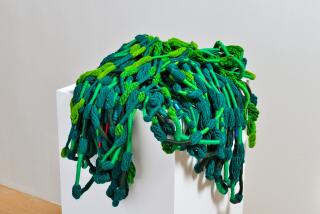Santa Monica
- Share via
Born in Italy in 1932, artist Italo Scanga attributes his penchant for recycling things to the poverty of his childhood. Everything but the kitchen sink does turn up in Scanga’s sculptural collages, which incorporate wooden animals, papier-mache vegetables, vases of cut flowers, thick lengths of rope, antique scales and irons, and shoes (he’s particularly keen on simple peasant tools--scythes, shovels, etc.--and musical instruments). Structured for the most part on a vertical axis, Scanga’s pieces combine aspects of Cubism and folk art in a distinctly Italian way. Colorful and nakedly emotional, the work simultaneously celebrates and bemoans the human condition.
Three distinct bodies of work are on view here, all of which cast Scanga in the role of wise storyteller. A strong narrative line dominates all his work, and the stories he favors tend to lend themselves to grand gestures. (Previous series explored Ireland’s potato famine of the 19th Century, the Allied bombing of Germany during World War II, and the subject of fear). Here we see a celebration of life titled “Memories and Poetics,” an inquiry into the various problems plaguing planet earth called “Troubled World” and an interpretation of the 14 stations of the cross titled “Fourteen Stations.” The most engaging of the three is “Memories and Poetics,” which has a homespun cheerfulness that makes the other work appear comparatively glum and dour. Glum it may be, but Scanga is to be commended for the degree of his engagement with the world around him at a time when many artists think life begins and ends within the pages of art magazines. (Dorothy Goldeen Gallery, 1547 9th St., to Feb. 11.)
More to Read
The biggest entertainment stories
Get our big stories about Hollywood, film, television, music, arts, culture and more right in your inbox as soon as they publish.
You may occasionally receive promotional content from the Los Angeles Times.










